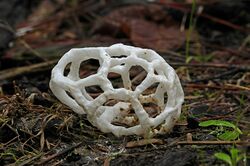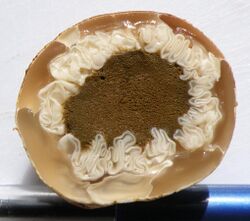Biology:Ileodictyon cibarium
| Basket fungus | |
|---|---|

| |
| Scientific classification | |
| Domain: | Eukaryota |
| Kingdom: | Fungi |
| Division: | Basidiomycota |
| Class: | Agaricomycetes |
| Order: | Phallales |
| Family: | Phallaceae |
| Genus: | Ileodictyon |
| Species: | I. cibarium
|
| Binomial name | |
| Ileodictyon cibarium Tul. & C. Tul. (1844)
| |
| Ileodictyon cibarium | |
|---|---|
| Mycological characteristics | |
| glebal hymenium | |
| no distinct cap | |
| hymenium attachment is irregular or not applicable | |
| lacks a stipe | |
| spore print is olive-brown | |
| ecology is saprotrophic | |
| edibility: not recommended | |
Ileodictyon cibarium is a saprotrophic species of fungus in the family Phallaceae. It is native to Australia and New Zealand, where it is commonly known as the basket fungus or the white basket fungus, alluding to its fruit bodies, shaped like a round or oval ball with interlaced or latticed branches, resembling polyhedra similar to closed fullerenes.[1] Although the immature spherical fruitbodies are reportedly edible, the mature fruit body is foul-smelling and partly covered with a slime layer containing spores (gleba) on the inner surfaces.
Taxonomy and etymology
Ileodictyon cibarium was originally described by Edmond Tulasne and Charles Tulasne in a paper by Étienne Raoul in 1844.[2] The type specimen was collected in New Zealand.[2][3][4]
The Māori language has 35[citation needed] different names referring to I. cibarium. These include tūtae kēhua ("ghost droppings"), tūtae whatitiri, and whareatua ("house of the devil"), kōkirikiriwhetū, kōpurawhetū, korokorowhetū, wheterau, popowhaitiri, tikowhatitiri, paruwhatitiri, matakupenga, and tūtae whetū. Several of the names refer to whaitiri, the atua and personification of thunder, this is because of the frequent appearance of I. cibarium fruit bodies following thunderstorms.[5][6]
In a 2018 poll, I. cibarium was ranked second by Manaaki Whenua – Landcare Research for its pick as New Zealand's national fungus, being defeated by Entoloma hochstetteri.[7]
Description
Prior to the opening of the outer skin, the fruit body is egg-shaped and white to greyish. After opening, it is a whitish mesh-like ball measuring up to 25 cm in diameter.[8] The different growth stages of L. cibarium were illustrated by John Buchanan.[9][10]
Ileodictyon cibarium is similar to and sometimes confused with Ileodictyon gracile (smooth cage fungus), which is also native to Australia. The two species are both whitish, mesh balls of similar size, but can be differentiated by characteristics of the receptacle arms that form the mesh.[11] I. cibarium has a thicker mesh[12] with arms that are wrinkled, about 5 times wider, elliptical in cross section, and not thickened where the arms meet, compared to I. gracile.[13][11]
Distribution and habitat
Ileodictyon cibarium is native to New Zealand and Australia and has also been found in Chile and Brazil as well as in Africa, probably as a result of it being introduced.[11][14] It is also known from several sites in England, where it is certainly introduced.[15] It grows alone or clustered together near woody debris, in lawns, gardens, and cultivated soil, along roads, in forest.[8]
Edibility
The immature fruitbodies are edible.[16][unreliable source?]
References
- ↑ Gooday, Graham W.; Zerning, John (1997). "Ileodictyon cibarium, The basket fungus as a buckyball". Mycologist 11 (4): 184–186. doi:10.1016/S0269-915X(97)80105-X. ISSN 0269-915X.
- ↑ 2.0 2.1 Raoul, Étienne (1844). "Choix de Plantes de la Nouvelle-Zelande". Ann. Sci. Nat., Bot. 3e (Sér. 2): 114. https://www.biodiversitylibrary.org/page/41531781.
- ↑ "Ileodictyon cibarium Tul. & C. Tul. 1844 - Biota of NZ". https://biotanz.landcareresearch.co.nz/scientific-names/1cb18f1e-36b9-11d5-9548-00d0592d548c.
- ↑ May, Tom W. (2003-09-01). "The status of names and records of Australian macrofungi". New Zealand Journal of Botany 41 (3): 379–389. doi:10.1080/0028825X.2003.9512857. ISSN 0028-825X. https://doi.org/10.1080/0028825X.2003.9512857.
- ↑ "tūtae whetū - Māori Dictionary". https://maoridictionary.co.nz/word/40079.
- ↑ Pallante, Joseph (19 July 2020). "The Alienness of White Basket Fungus". https://nzfungi.com/the-alienness-of-white-basket-fungus/.
- ↑ "New Zealand's favourite fungus has been revealed" (in en-nz). 8 June 2018. https://www.rnz.co.nz/news/national/359177/new-zealand-s-favourite-fungus-has-been-revealed.
- ↑ 8.0 8.1 "Ileodictyon cibarium" (in en). Queensland Mycological Society. November 2017. http://qldfungi.org.au/wp-content/uploads/FoQs/I-Misc/Ileodictyon-cibarium.pdf.
- ↑ Buchanan, Peter K.; Cooper, Jerry A. (2020). "John Buchanan's pre-1880 Records and Illustrations of New Zealand Fungi". Records of the Auckland Museum 55: 29–36. ISSN 1174-9202. https://www.jstor.org/stable/27008991.
- ↑ Buchanan, John. Botanical Notebook, 1866-1886, MS-41. Auckland War Memorial Museum Tāmaki Paenga Hira. pp. 161.
- ↑ 11.0 11.1 11.2 , Wikidata Q113536473
- ↑ Kuo, M. (August 2022). "Ileodictyon gracile (MushroomExpert.Com)". http://www.mushroomexpert.com/ileodictyon_gracile.html.
- ↑ "Ileodictyon gracile" (in en). Queensland Mycological Society. November 2017. https://qldfungi.org.au/wp-content/uploads/FoQs/I-Misc/Ileodictyon-gracile.pdf.
- ↑ , Wikidata Q113536686
- ↑ British Puffballs, Earthstars and Stinkhorns: An Account of the British Gasteroid Fungi. Kew, UK: Royal Botanic Gardens. 1995. p. 184. ISBN 0-947643-81-8.
- ↑ Glynn, Angela Prain, Lizzy. "Ghost Droppings". https://hail.to/raglan-area-school-community/article/aOZYz15.
External links
- Ileodictyon cibarium in the NZFUNGI database
- Mushroom Expert
- Ileodictyon cibarium occurrence data from Australasian Virtual Herbarium
- Ileodictyon cibarium discussed in RNZ Critter of the Week, 19 August 2022
Wikidata ☰ Q5997602 entry
 |


